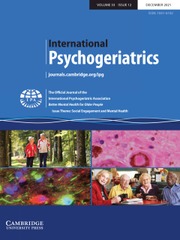Crossref Citations
This article has been cited by the following publications. This list is generated based on data provided by
Crossref.
Jung, Woo-Yul
Park, Joon-Ho
Lee, Soyoung Irene
Kim, Shin-Gyeom
Na, Kyeong-Sae
and
Jung, Han-Yong
2012.
The Trend of the Use of Neuropsychological Tests in the Korean Psychiatric Division for the Past 10 Years : Focused on Dementia Research.
Journal of Korean Neuropsychiatric Association,
Vol. 51,
Issue. 5,
p.
318.
McCarten, J. Riley
2013.
Clinical Evaluation of Early Cognitive Symptoms.
Clinics in Geriatric Medicine,
Vol. 29,
Issue. 4,
p.
791.
Bernick, C.
Banks, S.
Phillips, M.
Lowe, M.
Shin, W.
Obuchowski, N.
Jones, S.
and
Modic, M.
2013.
Professional Fighters Brain Health Study: Rationale and Methods.
American Journal of Epidemiology,
Vol. 178,
Issue. 2,
p.
280.
Kolenc, Matej
Moharić, Metka
Kobal, Jan
and
Podnar, Simon
2014.
Bladder dysfunction in presymptomatic gene carriers and patients with Huntington’s disease.
Journal of Neurology,
Vol. 261,
Issue. 12,
p.
2360.
Kolenc, Matej
Kobal, Jan
and
Podnar, Simon
2015.
Male sexual function in presymptomatic gene carriers and patients with Huntington's disease.
Journal of the Neurological Sciences,
Vol. 359,
Issue. 1-2,
p.
312.
Molina, Juan L.
González Alemán, Gabriela
Florenzano, Néstor
Padilla, Eduardo
Calvó, María
Guerrero, Gonzalo
Kamis, Danielle
Stratton, Lee
Toranzo, Juan
Molina Rangeon, Beatriz
Hernández Cuervo, Helena
Bourdieu, Mercedes
Sedó, Manuel
Strejilevich, Sergio
Cloninger, Claude Robert
Escobar, Javier I.
and
de Erausquin, Gabriel A.
2016.
Prediction of Neurocognitive Deficits by Parkinsonian Motor Impairment in Schizophrenia: A Study in Neuroleptic-Naïve Subjects, Unaffected First-Degree Relatives and Healthy Controls From an Indigenous Population.
Schizophrenia Bulletin,
Vol. 42,
Issue. 6,
p.
1486.
Elsas, S.
and
Hägele-Link, S.
2016.
Der Begriff der Nerventätigkeit in der Pathogenese neurodegenerativer Erkrankungen und ganzheitliche Therapiemöglichkeiten bei M. Parkinson.
Der Merkurstab,
Vol. 69,
Issue. 5,
p.
345.
Wu, Yi-Jen
Tseng, Philip
Huang, Han-Wei
Hu, Jon-Fan
Juan, Chi-Hung
Hsu, Kuei-Sen
and
Lin, Chou-Ching
2016.
The Facilitative Effect of Transcranial Direct Current Stimulation on Visuospatial Working Memory in Patients with Diabetic Polyneuropathy: A Pre–post Sham-Controlled Study.
Frontiers in Human Neuroscience,
Vol. 10,
Issue. ,
Kolenc, Matej
Kobal, Jan
and
Podnar, Simon
2017.
Female Sexual Dysfunction in Presymptomatic Mutation Carriers and Patients with Huntington’s Disease.
Journal of Huntington's Disease,
Vol. 6,
Issue. 2,
p.
105.
Overbeck, Jeannette
and
Schweers, Frank-Michael
2017.
Neuropsychological Outcome following Resuscitation after Out-of-Hospital Cardiac Arrest: A One-Year Follow-Up.
Case Reports in Cardiology,
Vol. 2017,
Issue. ,
p.
1.
Kalbfleisch, Layne
2017.
Executive Functions in Health and Disease.
p.
143.
Schölderle, Theresa
Staiger, Anja
and
Ziegler, Wolfram
2018.
The feasibility of assessing speech and non-speech function of the speech apparatus in adults with cerebral palsy.
Clinical Linguistics & Phonetics,
Vol. 32,
Issue. 9,
p.
876.
Mitsuhashi, Shota
Hirata, Shogo
Okuzumi, Hideyuki
and
Walla, Peter
2018.
Role of inner speech on the Luria hand test.
Cogent Psychology,
Vol. 5,
Issue. 1,
p.
1449485.
McGehrin, Kevin
Konersman, Chamindra
and
Ellis, Ronald
2018.
Clinical Reasoning: A 22-year-old postpartum woman with new-onset seizures and headache.
Neurology,
Vol. 90,
Issue. 18,
Mitsuhashi, Shota
Hirata, Shogo
and
Okuzumi, Hideyuki
2018.
Role of Inner Speech on Serial Recall in Children with ASD: A Pilot Study Using the Luria Hand Test.
Autism Research and Treatment,
Vol. 2018,
Issue. ,
p.
1.
van Cranenburgh, Ben
2018.
Neuropsychologie.
p.
423.
Stępień, Paula
Kawa, Jacek
Wieczorek, Dariusz
Dąbrowska, Magda
Sławek, Jarosław
and
Sitek, Emilia J.
2019.
Information Technology in Biomedicine.
Vol. 762,
Issue. ,
p.
561.
Anderson, David G.
Ferreira‐Correia, Aline
Rodrigues, Filipe B.
Aziz, N. Ahmad
Carr, Jonathan
Wild, Edward J.
Margolis, Russell L.
and
Krause, Amanda
2019.
Comparison of the Huntington's Disease like 2 and Huntington's Disease Clinical Phenotypes.
Movement Disorders Clinical Practice,
Vol. 6,
Issue. 4,
p.
302.
Plutino, Andrea
Camerucci, Emanuele
Ranaldi, Valentina
Baldinelli, Sara
Fiori, Chiara
Silvestrini, Mauro
and
Luzzi, Simona
2020.
Insight in frontotemporal dementia and progressive supranuclear palsy.
Neurological Sciences,
Vol. 41,
Issue. 8,
p.
2135.
Çırak, Musa
Yağmurlu, Kaan
Kearns, Kathryn N.
Ribas, Eduardo C.
Urgun, Kamran
Shaffrey, Mark E.
and
Kalani, M. Yashar S.
2020.
The Caudate Nucleus: Its Connections, Surgical Implications, and Related Complications.
World Neurosurgery,
Vol. 139,
Issue. ,
p.
e428.


